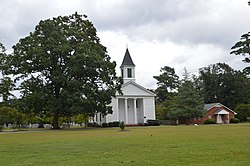Philadelphus Presbyterian Church | |
 Distant view from the road | |
| Location | SR 1318 SW of jct. with NC 72, Philadelphus, North Carolina |
|---|---|
| Coordinates | 34°45′52″N79°10′46″W / 34.76444°N 79.17944°W |
| Area | 7 acres (2.8 ha) |
| Built | 1858 |
| Architect | Gilbert P. Higley |
| Architectural style | Greek Revival |
| NRHP reference No. | 75001287 [1] |
| Added to NRHP | October 3, 1975 |
Philadelphus Presbyterian Church, is a historic Presbyterian church located near Philadelphus, Robeson County, North Carolina. It was built during the Antebellum era, in 1858, by carpenter Gilbert P. Higley. [1] This church replaced an earlier one which had been in existence since at least 1795. [2] The new church by Higley was constructed in the Greek Revival style with an in antis portico (columns on either side of the entranceway) and was able to accommodate a two-story sanctuary and gallery. [3] [4]
The property was listed on the National Register of Historic Places in 1975. [1]



